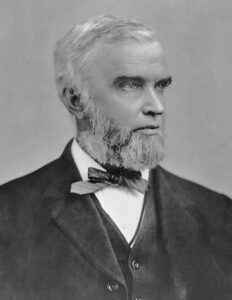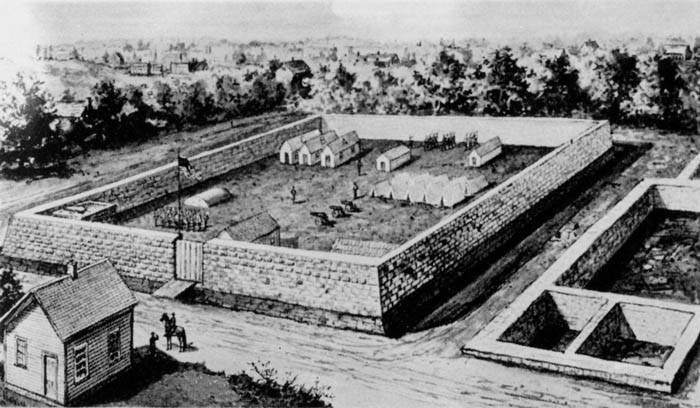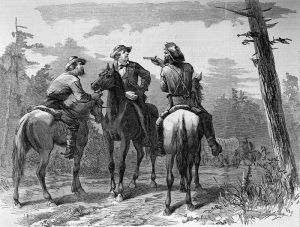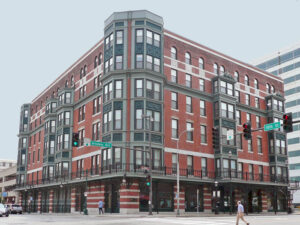
Camp Union in Kansas City, Missouri, during the Civil War.
Camp Union, also known as Fort Union, in Kansas City, Missouri, was established after the Civil War began on April 12, 1861.
When the war between the states began, things would change for the City of Kansas. It had seen the trouble to come in the Border War before Kansas became a Free-State. Now, however, there was no more neutrality. The citizens were equally divided for and against the Union, and neighbors, friends, and relatives took sides which was a blow to the city.
In the months immediately before the war’s outbreak, the leaders of the City of Kansas (later Kansas City) preferred to stay neutral and focus on the local economy instead.
The Missouri Constitutional Convention, held two months before the war began, determined that Missouri would not secede from the Union. Though its delegates declared the state’s official position to be “neutral,” Missouri Governor Claiborne Jackson supported the secessionists. From April until June, Missouri effectively had two state governments, with the pro-Confederate faction controlling the state capital in Jefferson City. The situation was unpredictable and potentially dangerous.
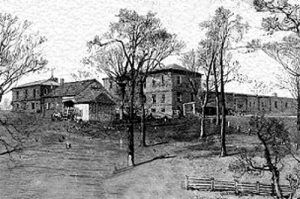
Liberty Arsenal, Missouri
Just days after the battle at Fort Sumter in South Carolina, Governor Jackson ordered the state militia to attack a Union Arsenal in Liberty, Missouri. On April 20, the Southern sympathizers captured about 1000 muskets, four brass field pieces, and a small amount of ammunition. It was the first civilian Civil War hostility against the Federal government in the state.
Before the war erupted, Robert T. Van Horn, Kansas City newspaperman, and avowed Unionist, became the mayor of the City of Kansas. He won a close election against a pro-secessionist candidate by adopting a “moderate” platform that supported pro-slavery views and loyalty to the Union simultaneously. When the war erupted, Van Horn enlisted in the Union Army and served as a lieutenant colonel of the Twenty-fifth Regiment, Missouri Volunteer Infantry.
In April 1861, pro-Southernists denounced Van Horn’s authority as mayor because of his pro-Union declarations. Governor Jackson ordered Van Horn to resign as major. Instead, Van Horn sought and received a commission of the rank of “major” from the Union Army and remained the mayor of Kansas City.
Kansas City’s tentative pro-Union stance was under attack on April 30, when Kansas City residents in favor of secession raised a Confederate flag at present-day Second and Main Streets. In response, Van Horn denounced this visible sign of Confederate influence in the city and requested Union reinforcements from Fort Leavenworth, Kansas.
In preparation for war, newspapers were suspended, business houses were closed, and many citizens left the city for more quiet places, reducing the population. Immediately on the commencement of hostilities, bands of Missouri bushwhackers began to plunder under the guise of partisanship. Likewise, Jayhawkers and Redlegs from Kansas took advantage of these opportunities and strove to crush out the town at the mouth of the Kansas River.
On June 14, seven companies of U.S. troops entered the city to secure it for the Union. Captain W. E. Prince led the force of two infantry companies and five cavalry companies. Van Horn also organized a local defense unit called the “Home Guard” to assist the Union troops.
The soldiers were briefly headquartered on Walnut Street before moving to 10th Street and Broadway. At this site, construction had begun in 1857 for the building of the Broadway Hotel. However, work was halted for the duration of the war. Here, the troops established Camp Union.
A 200-square-foot earthwork was erected around the site, and the unfinished hotel foundation was converted into a stable for the cavalry horses. Barracks and service buildings were built within the earthworks. Two howitzers and a single cannon were installed during the Bleeding Kansas conflict to defend the camp. Along with the camp, there were quartermaster’s stables on the opposite side of 10th Street, a commissary warehouse on the riverbank, and a hospital in the Farmer’s Hotel on Grand Avenue.
In the following months and years, the Union soldiers quelled dissent among Confederate sympathizers throughout the city. The cannon was used to warn the area of impending danger.
“I remember it well, with its old cannon that always looked so formidable, its adjoining barracks, and the dear old flag that waved so proudly over all.”
— Laura Coates Reed, daughter of Kersey and Sarah Coates
In the meantime, Major Robert Van Horn commanded the 25th Regiment of the Missouri Volunteer Infantry. However, he was wounded at the Battle of Lexington and was taken prisoner by the Missouri State Guard on September 20, 1861. He was released in November 1861 per an agreement made between Union Major General John C. Fremont and Confederate Major General Sterling Price. After returning home, he was elected to the Missouri Senate in 1862 and was again elected Mayor of Kansas City two years later.
Confederate raiders threatened Kansas City and the area as secessionist guerillas continued to suppress trade into and out of the city and ravaged much of the surrounding farmland. The Union held Kansas City, but the tide of trade and travel no longer came to the City of Kansas and passed on to Leavenworth, Atchison, and other Kansas towns.
In October 1864, General Sterling Price lost the largest battle in the Western Theater of the war. The Battle of Westport occurred in present-day Kansas City, Missouri. This defeat led to the virtual collapse of the Army of Missouri and ended any chance of bringing Missouri into the Confederacy.
Camp Union was dismantled after the end of the Civil War in 1867, and work resumed on the five-story Broadway Hotel. However, it did not prosper, and Kersey Coates acquired it in 1870 and renamed it the Coates House Hotel. After Kersey Coates died in 1887, his widow and family demolished the original hotel and began building a new Coates House Hotel on the same site in 1888.
©Kathy Alexander/Legends of America, June 2023.
Also See:
Sources:
Civil War on the Western Border
The Clio
Historical Marker Database
Kansas City Public Library
Martin City Telegraph

